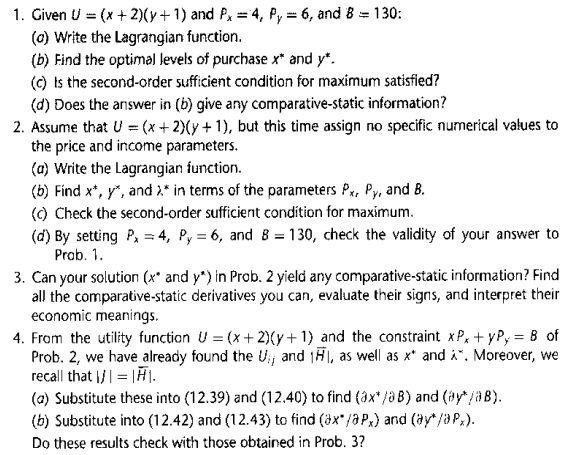Question
Given U=(x+2)(y+1) and P_(x)=4,P_(y)=6 , and B=130 : (a) Write the Lagrangian function. (b) Find the optimal levels of purchase x^(**) and y^(**) . (c)
Given
U=(x+2)(y+1)and
P_(x)=4,P_(y)=6, and
B=130:\ (a) Write the Lagrangian function.\ (b) Find the optimal levels of purchase
x^(**)and
y^(**).\ (c) is the second-order sufficient condition for maximum satisfied?\ (d) Does the answer in (b) give any comparative-static information?\ Assume that
U=(x+2)(y+1), but this time assign no specific numerical values to\ the price and income parameters.\ (a) Write the Lagrangian function.\ (b) Find
x^(**),y^(**), and
\\\\lambda ^(**)in terms of the parameters
P_(x_(r))P_(y), and
B.\ (c) Check the second-order sufficient condition for maximum.\ (d) By setting
P_(x)=4,P_(y)=6, and
B=130, check the validity of your answer to\ Prob. 1.\ Can your solution and
{:y^(**))in Prob. 2 yield any comparative-static information? Find\ all the comparative-static derivatives you can, evaluate their signs, and interpret their\ economic meanings.\ From the utility function
U=(x+2)(y+1)and the constraint
xP_(x)+yP_(y)=Bof\ Prob. 2, we have already found the
U_(ij)and
|vec(H)|, as well as
x^(**)and
\\\\lambda ^(**). Moreover, we\ recall that
|J|=(|)/(b)ar (H)|.\ (a) Substitute these into (12.39) and
(12.40)to find
(del(x^(**))/(d)elB)and
(del(y^(**))/(d)elB).\ (b) Substitute into
(12.42)and
(12.43)to find
(del(x^(**))/(d)elP_(x))and
(del(y^(**))/(d)elP_(x)).\ Do these results check with those obtained in Prob. 3?

Step by Step Solution
There are 3 Steps involved in it
Step: 1

Get Instant Access to Expert-Tailored Solutions
See step-by-step solutions with expert insights and AI powered tools for academic success
Step: 2

Step: 3

Ace Your Homework with AI
Get the answers you need in no time with our AI-driven, step-by-step assistance
Get Started


